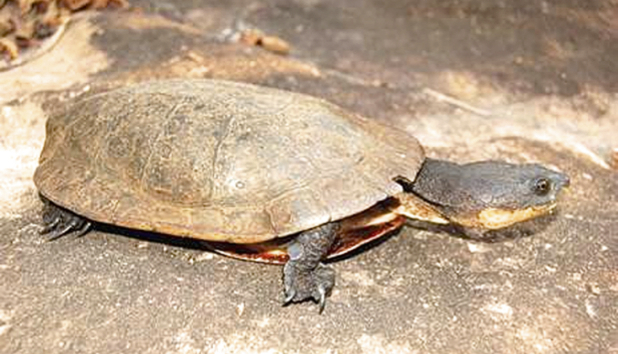Mesoclemmys vanderhaegei, 083
Mesoclemmys vanderhaegei (Bour 1973) –
Vanderhaege’s Toad-headed Turtle, Karumbé-hy
Thiago S. Marques1, Stephan Böhm2, Elizângela S. Brito3,
Mario R. Cabrera4, and Luciano M. Verdade1
1Laboratório de Ecologia Isotópica, Centro de Energia Nuclear na Agricultura, Universidade de São Paulo,
C.P. 96, 13416-000, Piracicaba, São Paulo, Brazil [[email protected]; [email protected]];
2Johannagasse 18/16, 1050 Wien, Austria [[email protected]];
3Programa de Pós-graduação em Biologia de Água Doce e Pesca Interior (BADPI), Instituto Nacional de Pesquisas da Amazônia, Avenida André Araújo 2936, 69067-375 Manaus, Amazonas, Brazil [[email protected]];
4Museo de Zoología and Instituto de Diversidad y Ecología Animal (CONICET/UNC), Universidad Nacional de Córdoba, Vélez Sarsfield 299, (5000) Córdoba, Argentina [[email protected]]
Summary. – Vanderhaege’s Toad-headed Turtle, Mesoclemmys vanderhaegei (Family Chelidae), is a poorly known freshwater turtle that is widely distributed in central South America. It occurs in the Amazonas, Tocantins, Paraguay, Parana, and Uruguay River basins, where it inhabits shallow streams, ponds, and marshes. Its taxonomic status has long been uncertain and confusion with similar looking species of toad-headed turtles still occurs frequently, leading to erroneous distribution records. Adults can reach up to 285 mm straight carapace length. No subspecies are currently recognized, although there are obvious differences in shell, iris coloration, and body size among populations. The species seems to rely mainly on a carnivorous or opportunistic omnivorous diet. Females are capable of depositing more than one clutch per year with a mean clutch size of 6.4 ± 3.9 eggs. Due to its great ecological adaptability, the species occurs in pristine habitats as well as agricultural and urban areas, but with a cryptic lifestyle. There is little known about its basic ecology except for local studies in Brazil, but detailed ecological surveys in Paraguay and Argentina are lacking. The current population status cannot be fully determined.
Distribution. – Argentina, Bolivia, Brazil, Paraguay. Occurs in portions of the Amazonas, Tocantins, Paraguay, Parana, and Uruguay drainage basins, and in montane streams of Santa Cruz in Bolivia.
Synonymy. – Phrynops schöpfii Fitzinger in Diesing 1839 (nomen nudum), Phrynops schoepffii Fitzinger in Siebenrock 1904 (nomen nudum, partim), Phrynops paraguayensis Vanzolini in Donoso-Barros 1965 (nomen nudum), Phrynops tuberculatus vanderhaegei Bour 1973, Phrynops (Batrachemys) vanderhaegei, Phrynops vanderhaegei, Batrachemys vanderhaegei, Bufocephala vanderhaegei, Mesoclemmys vanderhaegei.
Subspecies. – None recognized.
Status. – IUCN 2014 Red List: Lower Risk/Near Threatened (NT, assessed 1996, needs updating); TFTSG Draft 2012: Near Threatened or Data Deficient; CITES: not listed; Brazil: not listed; São Paulo state: Insufficient data; Argentina: Data deficient.
Citation:
Marques, T.S., Böhm, S., Brito, E.S., Cabrera, M.R., and Verdade, L.M. 2014. Mesoclemmys vanderhaegei (Bour 1973) – Vanderhaege’s Toad-headed Turtle, Karumbé-hy. In: Rhodin, A.G.J., Pritchard, P.C.H., van Dijk, P.P., Saumure, R.A., Buhlmann, K.A., Iverson, J.B., and Mittermeier, R.A. (Eds.). Conservation Biology of Freshwater Turtles and Tortoises: A Compilation Project of the IUCN/SSC Tortoise and Freshwater Turtle Specialist Group. Chelonian Research Monographs 5(7):083.1–8, doi:10.3854/crm.5.083.vanderhaegei.v1.2014, //iucn-tftsg.org/cbftt/.
(Adobe Acrobat 6.0 or later required)

Mesoclemmys vanderhaegei from Cáceres, Mato Grosso, Brazil.
Photo by Elizângela S. Brito.
Distribution:

Distribution of Mesoclemmys vanderhaegei in Brazil, Bolivia, Paraguay, and Argentina in central South America. Purple lines = boundaries delimiting major watersheds (level 3 hydrologic unit compartments – HUCs); red dots = museum and literature occurrence records of native populations based on Iverson (1992) plus more recent and authors’ data; green shading = projected native distribution based on GIS-defined HUCs constructed around verified localities and then adding HUCs that connect known point localities in the same watershed or physiographic region, and similar habitats and elevations as verified HUCs (Buhlmann et al. 2009; TTWG 2014), and adjusted based on authors’ subsequent data.








